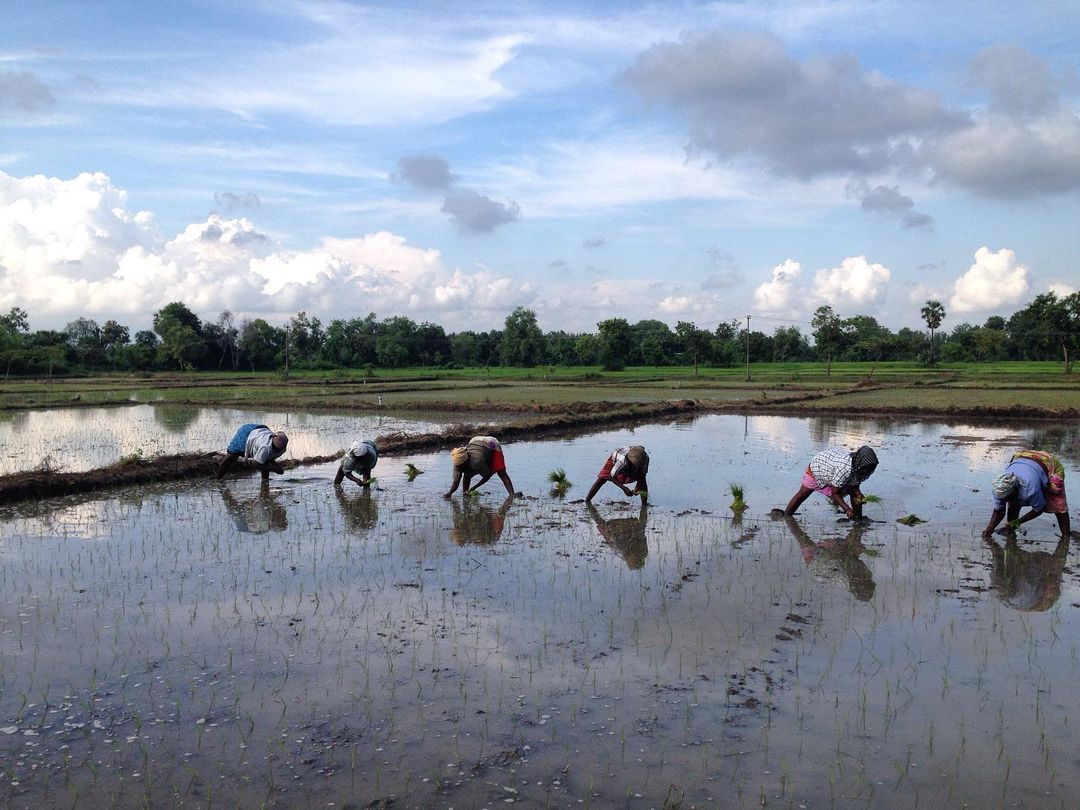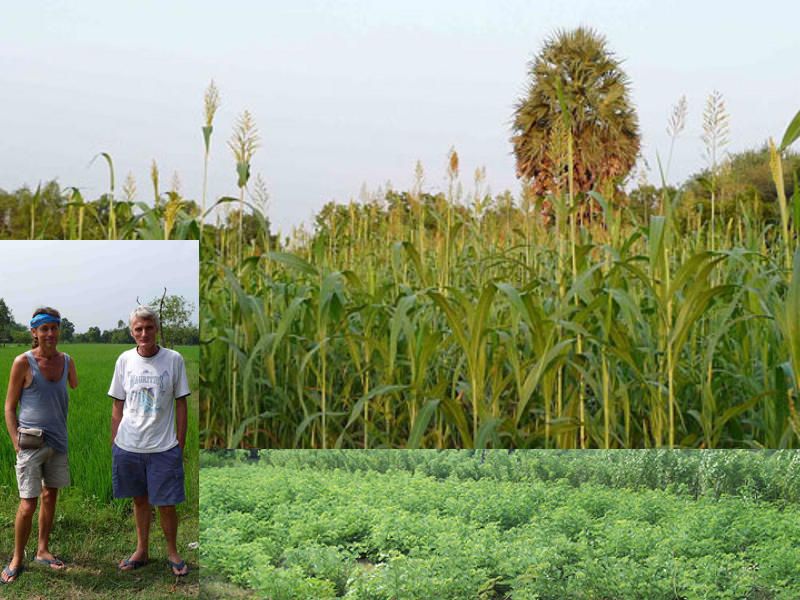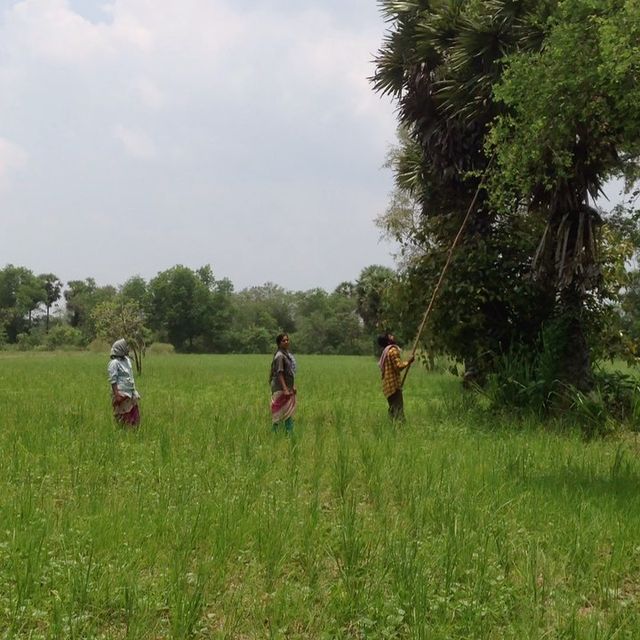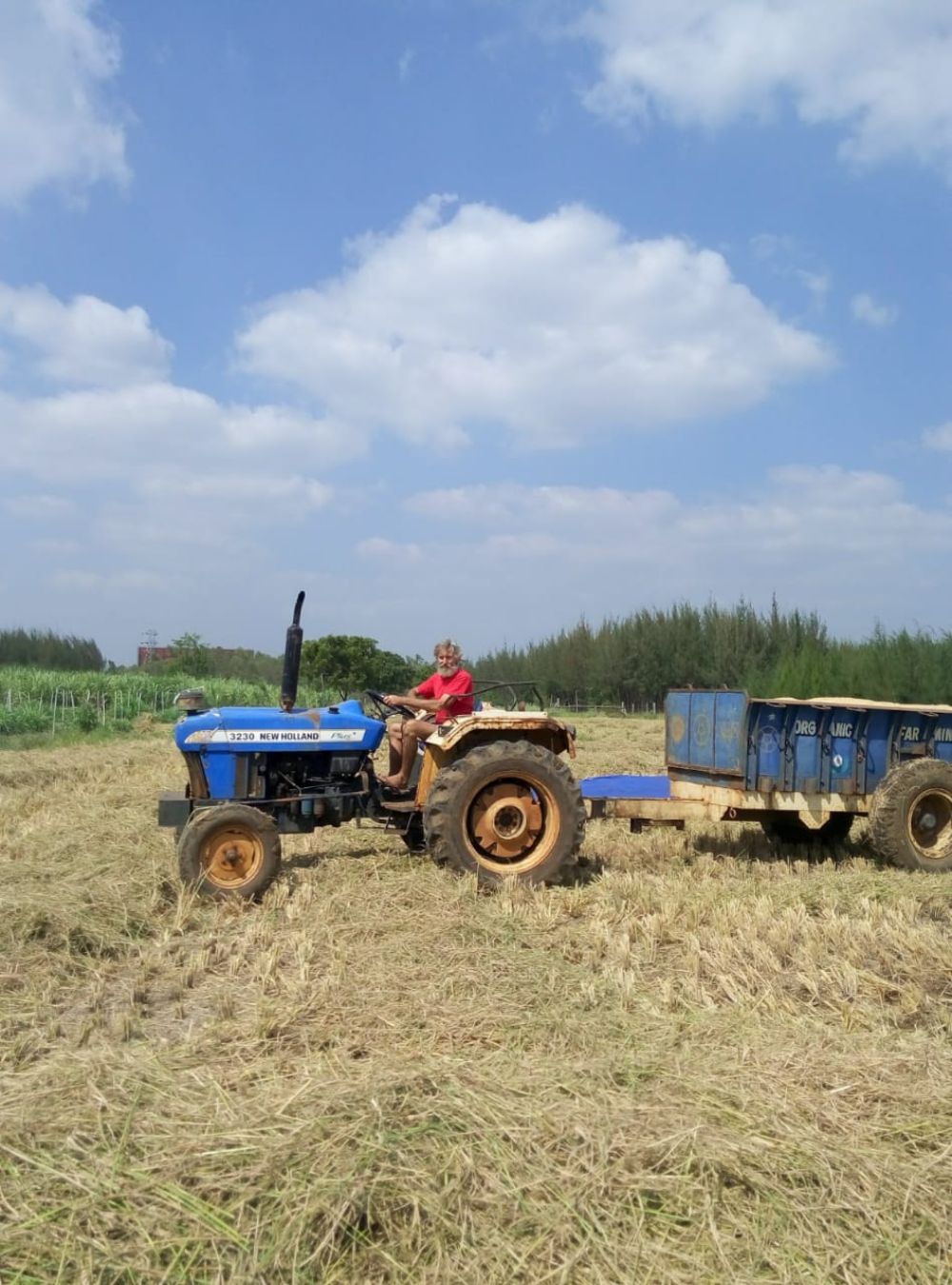Annapurna Farm

Located few kilometres away from the centre of Auroville, Annapurna farm is the largest farm of Auroville with 135 acres of land. Being production oriented to serve the needs of Auroville community, it produces staples such as different varieties of rice, milk, sesame, processed dairy, bananas and some other fruits. It is also the granary of Auroville. Annapurna manages the storage, processing and distribution of most grains produced in Auroville farms.
Introduction
Annapurna is a certified organic farm under the accreditation of IMO control, a certification body. With a certified organic dairy, Annapurna has a large herd of cows mainly bred from Gir, Sindi and Jersey genes. All of the rice varieties are organically grown with minimal external inputs. A medium-sized guava orchard and a banana plantation also exist on the farm. Tomas, Andre and Nidhin manage the different operations of the farm. The farm employs 18 full-time workers and additional casual labourers during the crop season.
With its core values of integrity and joy in work, the farm operates on the principles of sustainability by adopting the use of non-hybridized local seeds and efficient water management practices.
Annapurna Farm: Inception
Located about 10km from Auroville centre near Vanur village, the farm was purchased by Auroville in the late 1960s. Mainly used for experimental tree planting until the mid 80s by the first stewards, systematic farming began soon after.
Tomas and Andre, the current stewards, joined in 1986 and 1989 respectively. Over the decades that followed, many people have participated and contributed to the development of the farm. From the very beginning, rice-growing had been the focus of the farm. Over the years that followed, the size of the dairy also increased. More cows meant more manure could be produced for the farm. Premium organic cow milk also provided the farm with much-needed revenue to cover the costs of the operations. While small quantities of fruits and vegetables were always cultivated, it was only recently that the farm began to do a focused cultivation of guavas and bananas.
While different varieties of millets and grains were cultivated in the early years of the farm, the farm has currently retreated to growing rice due to poor economics and ecological challenges in cultivating millets. At the moment, the farm is exploring new and high yielding varieties of rice that can be grown. Over the last few years, the majority of the water requirement for the rice crop is met through harvested rainwater from water catchment ponds.
At Annapurna farm, around 30 acres are under intensive cultivation of which 23 acres are dedicated for rice cultivation. The remaining land serves some purpose to the farm as a whole. While some land is forested, other parts are used for water catchment, as well as grazing area for the cows and cultivation of green manure and other dryland crops.
White ponni, poovan samba, ‘KO 43’ and the homebred ‘Annapurna variety’ are some of the rice varieties that are cultivated at Annapurna. Of the 135 acres of land, about 30 acres is used for intensive farming. An average of 10000- 20000 kilograms of rice is produced each year.
Rice is planted in the middle of the southwest monsoon which starts in July and ends in September. The harvest usually takes place from January onwards. Other crops such as rosella, sesame and mustard are often cultivated during the cool season. The soil is heavy black cotton type which is quite favourable for rice growing. While seasonal rains are the main source of irrigation, harvested rainwater from the ponds is used when rainfall is insufficient. All the rice is milled at the farm itself to assure buyers of genuine organic and adulteration free products.
“It is only since a few years that the farm has looked more seriously into cultivation of fruit as a crop. Since rain-fed field crops are not viable anymore for various reasons the farm is looking for another direction and possibilities.
A few years back we planted a small orchard of half-acre of guava trees which we extended a year later to one acre. We also planted 1.5 acres of banana trees. Both these crops are doing ok and we are able to process all undersized and damaged fruits into fruit compote, making both these crops economically viable.
In the meantime, we have been planting the rain-fed areas with Gliricidia(a leguminous shrub) alleys so we can use these plants as mulch/compost materials to maintain the crops without having to purchase nutrients off the farm. Development (both in quality and quantity) of guava and banana plantations will continue slowly in the years to come since there is a high demand in Auroville for both fruits.”
- Tomas, steward of Annapurna farm
“Most visitors admire the beauty of the Annapurna cows. With their long horns, their proud mighty look and their impressive height they show the strength of the original Gir breed but one sees also the different breeds bred into the herd. Since the herd is fully bred on the farm there is a strong sense of hierarchy and harmony.
Today Annapurna’s dairy consists of around 30 animals from which half are adult and milking, the rest being young stock and a bull for breeding. Cows are crossbred with mostly indigenous breeds and some jersey cow breeds for improved milk yield.
We are in the process of increasing the herd to 16 milking animals, and an extra shed has been built to house the young animals (and bull) to be able to select new members. The demand for Annapurna’s dairy products is good. One of the reasons is the fact that Annapurna is a certified organic farm and people appreciate food safety and quality”
- Tomas, steward of Annapurna farm
“Today Annapurna dairy has at its disposal a fully functioning cheesery and a cool room. This has come a long way, where initially milk was all marketed directly, after which paneer was made to take care of the evening milk. Then we developed a process to mature the paneer to be able to overcome the summer glut of milk in a low Auroville market. Only after the farm got its electricity connection more fresh cheeses were developed and ultimately Rennet cheese was added to the collection after having built a cool room. To develop the various cheeses, different people were involved who all brought in specific skills needed to create a quality product. This process is ongoing and we hope to develop more kinds of dairy products in the years to come. Since some time Nidhin, a young Aurovillain coming from Kerala has been managing the dairy processing area.
Since a few years, the Indian hygiene standards organization (FSSAI) have been improved and imposed, which meant we had to separate the cheese processing from domestic activities and we created a small cheesery that complies with the current hygiene standards of India.”
- Tomas, steward at Annapurna farm
Annapurna has been trying for some time to meet the gap between supply and demand for rice and dairy. However, this comes with its own set of challenges considering the growing labour costs, electricity and water requirements. Water must be pumped from the ground or harvested, irrigation systems put in place and fertilisers are required to fulfil the needs.
While the diesel-powered pumps bring in water for crops during the dry seasons, Tomas and Andre have created three water catchment areas, with a fourth planned shortly, which fulfil the irrigation needs without the need to tap into groundwater sources.
To protect the crop from wild animals, cows and,of course, stray humans, the urgent need for fencing is to be taken up immediately. This again requires a huge monetary investment.
The current stewards are into their 60s and require a stable manager to take this rich legacy forward.
A sound understanding of the technicalities of managing a farm along with excellent people management skills is a key requirement. Considering the growing disinterest in farming activities, it would be a real challenge to find the right person(s) soon.
The cows in the dairy are currently fed grains suitable for human consumption which could otherwise be sold for good sums of money to be put to use for other developmental activities on the farm. This is due to a shortage of fodder. Therefore, another immediate requirement would be to cultivate more fodder which in turn needs more water, labour all adding up to more monetary expenses while reducing the milk output.
Therefore a fine balancing act is needed to ensure sustainability while ensuring economies of scale are met to keep the farm running successfully.
- Volunteer at Annapurna Farms - Development & Support
- Donate to us at Annapurna Support Fund
Get in Touch
annapurnafarm-auroville.org.in
instagram.com/annapurna.auroville
Tomas: Ph. 9489693801
Nidhin: Ph. 9566631079
See Also





